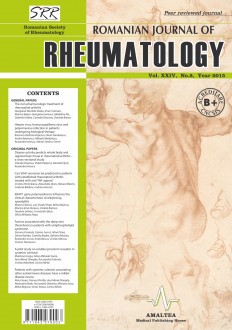SELECT ISSUE

Indexed

| |

|
|
|
| |
|
|
|

|
|
|
|
|
|
| |
|
|
HIGHLIGHTS
National Awards “Science and Research”
NEW! RJR has announced the annually National Award for "Science and Research" for the best scientific articles published throughout the year in the official journal.
Read the Recommendations for the Conduct, Reporting, Editing, and Publication of Scholarly work in Medical Journals.
The published medical research literature is a global public good. Medical journal editors have a social responsibility to promote global health by publishing, whenever possible, research that furthers health worldwide.
DISEASE ACTIVITY PREDICTS WHOLE BODY AND REGIONAL LEAN TISSUE IN RHEUMATOID ARTHRITIS – A CROSS-SECTIONAL STUDY
Claudiu Popescu, Violeta Bojinca, Daniela Opris and Ruxandra Ionescu
ABSTRACT
Aim. The study aims to assess the potential influences of rheumatoid arthritis (RA) and its specific disease measures on lean body composition phenotypes of female patients.
Methods. The study was cross-sectionally designed to include Caucasian postmenopausal female RA patients and age-matched postmenopausal female controls. All the subjects gave written informed consent and the study was approved by the local ethics committee. Each subject underwent in the same day a clinical examination, laboratory tests, whole body dual X-ray absorptiometry (DXA) composition and physical activity estimation using a self-administered questionnaire. Correlations, differences and predictive power were analyzed with appropriate statistical tests.
Results. The study included 107 RA patients and 104 controls. Compared to the normal subjects, who recorded higher levels of physical activity, the RA patients had significantly lower appendicular lean tissue absolute and relative indices and higher prevalence of sarcopenia. The whole body and appendicular lean tissue indices showed significant negative correlations with measures of disease severity (duration, inflammation, quality of life and radiographic progression), independent of age, levels of physical activity, body mass index and smoking.
Conclusions. The measures of disease activity and severity independently predict lean tissue phenotypes in RA patients, behaving as risk factors for sarcopenia and rheumatoid cachexia. The diagnosis of RA in itself is a significant predictive factor of sarcopenia.
Keywords: rheumatoid arthritis, dual X-ray absorptiometry, sarcopenia, cachexia
